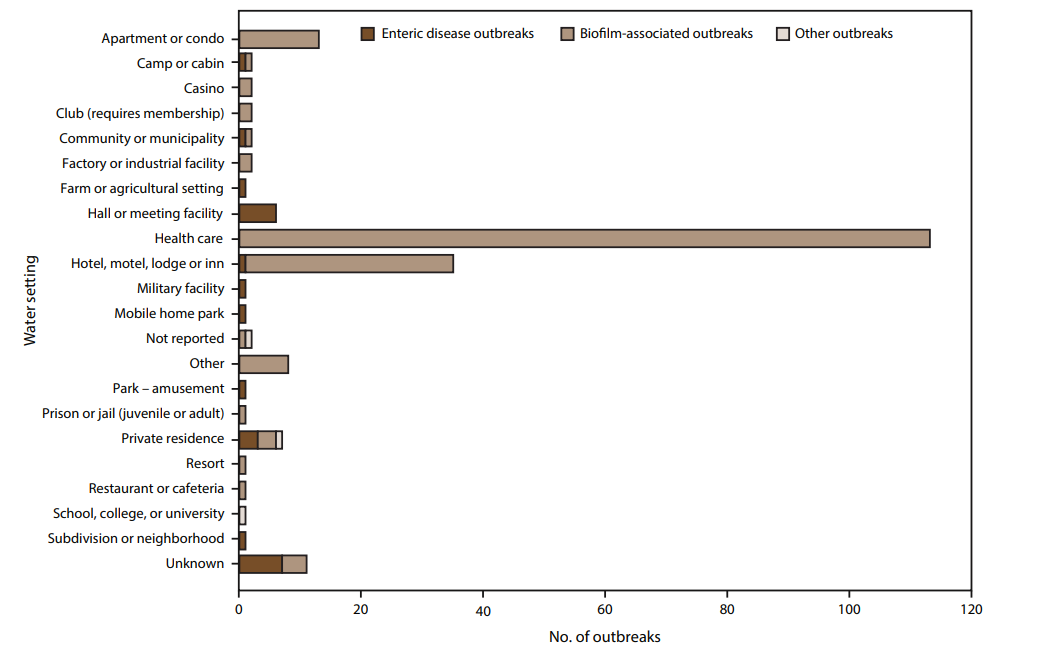Is tap water safe to drink? CDC report highlights deadly waterborne infections
(NEXSTAR) – The United States has one of the world’s safest public water systems, but a new report might make you think twice about drinking straight from the faucet.
Public health officials in more than two dozen states voluntarily reported a total of 214 intestine-related disease outbreaks associated with drinking water between 2015 and 2020, according to a recent analysis from the Centers for Disease Control and Prevention. The outbreaks resulted in at least 2,140 cases of illness, 563 hospitalizations, and 88 deaths.
The CDC noted that biofilms were the most common contributing factor. Biofilms, characterized as slimy coatings formed by groups of waterborne germs (like bacteria, fungi, and amoebas), create an environment where pathogens can thrive and multiply.
Legionella bacteria, frequently found in biofilms, were pinpointed as the leading cause of the outbreaks, particularly in public water systems. The Legionella-associated outbreaks resulted in 37% of illnesses, 97% of hospitalizations, and 98% of deaths outlined in the report.
According to the CDC, Legionella bacteria can cause a serious lung infection called Legionnaires’ disease. While it can be treated successfully, about 1 in 10 people who become infected “will die due to complications from their illness,” the agency stated on its website.
Other pathogens – such as norovirus, Shigella, and Campylobacter – were also implicated in some of the outbreaks. These pathogens, primarily tied to well water in the report, can lead to a range of illnesses affecting the intestines, lungs, brain, eyes or skin.
Of the states highlighted in the analysis, Illinois, Florida, Georgia, and Maryland reported the most outbreaks (all of which were Legionella-related). The table below breaks down the number of cases, hospitalizations and deaths in each of those states over the five-year period.
| State | Outbreaks | Cases | Hospitalizations | Deaths |
| Florida | 54 | 162 | 119 | 15 |
| Illinois | 29 | 140 | 101 | 26 |
| Maryland | 16 | 54 | 40 | 5 |
| Georgia | 13 | 43 | 42 | 6 |
States that reported 10 or fewer outbreaks during the same period were Arizona, Connecticut, Colorado, Hawaii, Idaho, Kansas, Kentucky, Massachusetts, Michigan, Minnesota, Missouri, Nevada, New York, North Carolina, Ohio, Oklahoma, Pennsylvania, Rhode Island, South Carolina, Tennessee, Texas, Utah, Virginia, Washington, and Wisconsin.
It’s important to note that not all of these states reported cases each year to the CDC’s National Outbreak Reporting System.
More than 450 people who fell ill (about 21% of all cases) were exposed to contaminated water at a health care facility, such as a hospital or assisted living center, according to the CDC. Hotels, motels, lodges or inns were linked to about 225 cases. Meanwhile, private residences, apartments or condominiums were associated with 19 cases.

Aside from bacteria like Legionella lurking in the water, some other factors that contributed to the outbreaks included aging plumbing components, home water treatment deficiencies, and contamination of plumbing during construction or repair.
The CDC said its report underscores the need for better water surveillance, prevention, and outbreak response programs.
Tips for safer drinking water
Now, you’re probably wondering if the tap water at your home is safe to drink.
There are more than 148,000 public water systems in the U.S. that are required to follow regulations set by the Environmental Protection Agency. Still, germs can get in the water we use for drinking, showering and other activities, according to the CDC.
While an occasional sip from the faucet might be harmless, you should remember that tap water is not sterile — so it’s best to avoid in some situations.
“Tap water should not be used in continuous positive pressure (CPAP) machines, for nasal irrigation or neti pots, in humidifiers, for cleaning contact lenses or to clean open wounds,” Dr. Rianna Yancey, an assistant research professor at the University of Maryland, told Parade.
To protect against “water-loving” germs at home, the CDC recommends the following:
- Boil water for 1-3 minutes and let it cool before use.
- Use a water filter labeled as “NSF 53” or “NSF 58.” Filters with an absolute pore size of 1 micron or smaller are also effective.
- Purchase distilled or sterile water, especially when using a device to flush sinuses.
- Flush your faucets and showerheads if you haven’t used them in a while.
- Regularly clean and upkeep all appliances that use water.
Copyright 2023 Nexstar Media Inc. All rights reserved. This material may not be published, broadcast, rewritten, or redistributed.

